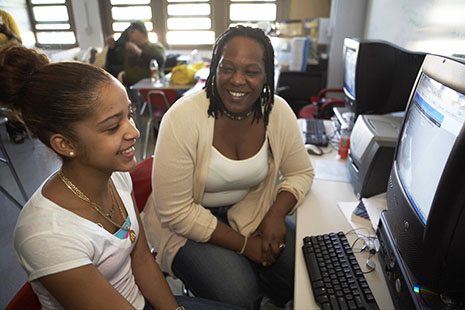SCRATCH any would-be education reformer among our political leaders and you’ll find someone who is easily excited by student test results. If the numbers go up then they prove the effectiveness of this or that innovation. If they go down then teachers aren’t making the effort or are accepting excuses for poor performance. And if one set of test results doesn’t provide the evidence you want, just search for another. The stakes are always high where tests like these are involved, and also at stake are the reputations of education-reformer politicians.
Nowhere is this more obvious than in New York, where optimistic and ever-improving results in the state’s own tests have been increasingly been contradicted by national test results for the same students. The New York Times reported on the latest figures last month, and the tabloid media – which has generally supported reforms driven by the current mayor, Michael Bloomberg – is starting to echo the doubts.
Australia’s deputy prime minister, Julia Gillard, has visited New York several times, and she has always come home – in the style of Bernard Shaw after his 1930s visits to the Soviet Union – proclaiming that she has seen the future. She is particularly enamoured of the New York City’s schools chancellor, Joel Klein, and recently joined a forum at the invitation of none other than Jeb Bush, former governor of Florida, to discuss education reform.
A few months ago I visited some schools in New York City, where I found a school system too big and complex to boil down to a few sentences. It has been through pendulum swings, from central to local control in the 1970s, and back to central control in this decade under Mayor Bloomberg, aided by Klein and his education department. There has always been a diversity of schools – and now even more so, with many of the larger schools broken up into smaller schools with identities built around specific programs.
Any visitor is struck by this diversity. The three schools I visited were small schools, each occupying one level of what were once multi-storey schools accommodating several thousand students. Specialisation on smaller campuses has encouraged new and very different models to emerge. I was impressed by the quality of the teaching I witnessed as a visitor. I was particularly taken by Bronx Guild school, which is driven by the Big Picture model – “generating and sustaining innovative, personalised schools that work in tandem with the real world of the greater community” – with a focus on re-engaging disadvantaged kids. Big Picture is also gaining traction in Australia.
But I walked away feeling that the achievements I witnessed had happened despite the system and not because of it. There’s nothing unique about this – as a school principal in New South Wales I always spent time protecting my staff from system silliness. In that role you must make sure that as little as possible gets in the way of teachers doing the best job possible, without distraction, in what is their core business – teaching and supporting their students.
But there are critical elements of the education system in NYC that just don’t seem to stack up, leaving many educators flummoxed by the efforts of Julia Gillard to import much of it into Australia. The system is driven by the same half-baked and unproven ideology of reform that resonates throughout much of the English-speaking educational world – with apologies to the Welsh and the Scots – with its success guaranteed by measures which serve political needs and, more often than not, undermine the real purpose and achievement of schools.
The reform ideology is strong on schemes and slogans – school choice, competition, charter schools, vouchers, accountability – but very weak on evidence and equally weak on lasting and meaningful results. Chester Finn, who drove much of this agenda across the United States under Ronald Reagan, recently summed it up in this way:
“[D]espite all the reforming, US [test] scores have remained essentially flat, graduation rates have remained essentially flat, and our international rankings have remained essentially flat. You can find some upward blips but you can also find downward blips. Big picture, over twenty-five years, is flat, flat, flat. In other words, all the reforming has yielded little or nothing by way of stronger outcomes.”
It’s enough to leave the most energetic reformer feeling… flat. But it hasn’t stopped various politicians and school system leaders, including Klein, from claiming success. What Bloomberg and his chancellor pitch as being measurable differences between the achievement of schools are inevitably measurements of enrolment profile, family income, neighbourhood differences and variations in school resources and management. Their claims are persuasively challenged by critics in the United States, and in Australia by Trevor Cobbold of Save Our Schools.
Recent research has shown once again that achievement tests – even accurate ones –do not adequately separate school and non-school effects on children’s learning. They tend to suggest that “failing” schools are the urban public schools that serve predominantly poor or minority students. The reality is far more complex, but the effect of publishing test scores – and coming to spurious conclusions about what they show – is to accelerate enrolment drift away from schools in poor areas. The greater isolation of struggling students in marginalised schools is not the way to improve school and system performance. As that researcher concludes, “current accountability systems that rely on achievement may do as much to undermine school quality as they do to promote it.”
Australia is a relatively high performing country but we already have a long academic tail, probably created – as OECD reports suggest – by how we arrange our schools as much as by what goes on inside them. The test-driven systems in NYC and across the United States – at best a middle ranking country in OECD assessments of student achievement – are delivering other things which we don’t want, especially in increasing the racial and social divides between schools. We don’t want to increase the element of social hierarchy that is increasingly evident among and between our public and private schools. And we certainly need to be wary about importing school reform solutions from a country where social mobility is low or declining.
But none of this seems likely to slow the inexorable drive to transplant the failed American experience into our schoolyards. Julia Gillard is not for turning, and her rhetoric about reform continues unabated – although the phrase “evidence-based policy” seems to have been dropped from her script. It is a triumph of politics over sound policy, a no-risk or low-risk strategy that resonates and sells well, with the only opponents easily pushed into a corner. •




